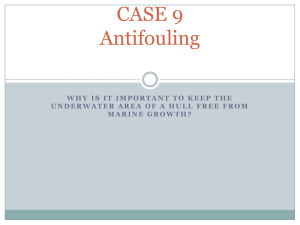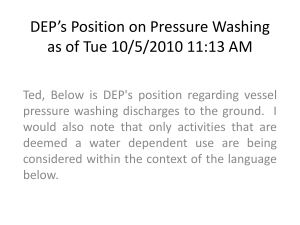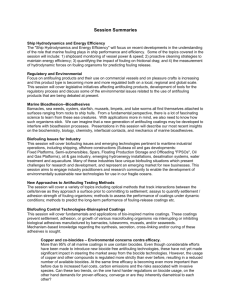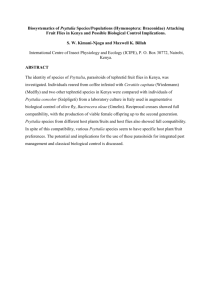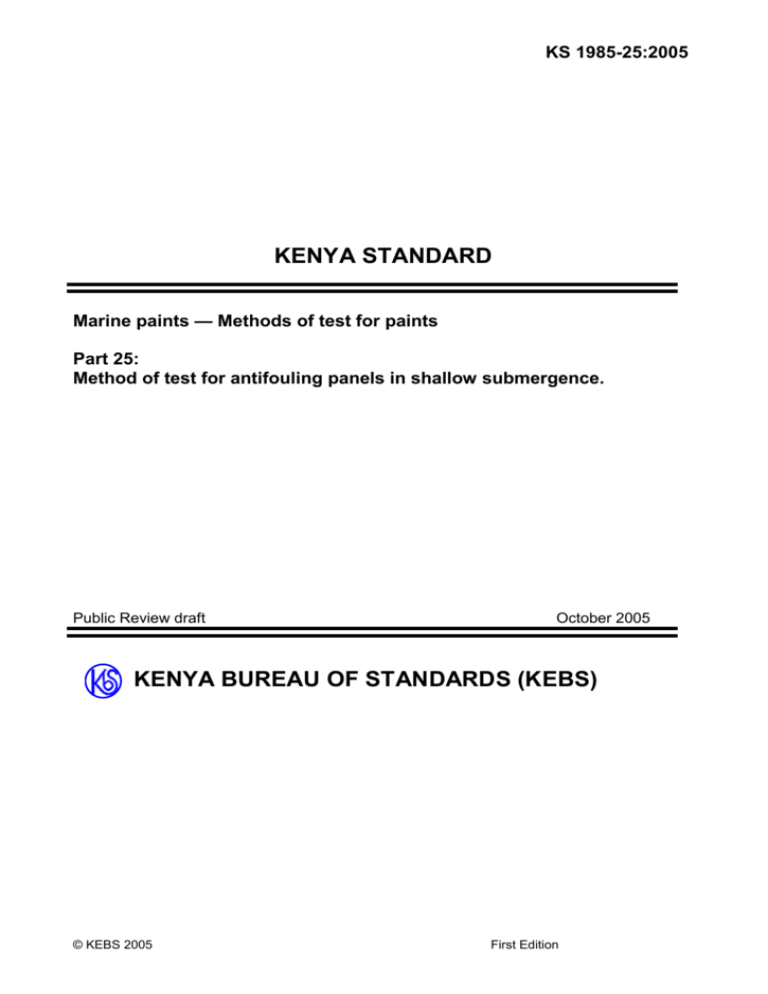
KS 1985-25:2005
KENYA STANDARD
Marine paints — Methods of test for paints
Part 25:
Method of test for antifouling panels in shallow submergence.
Public Review draft
October 2005
KENYA BUREAU OF STANDARDS (KEBS)
© KEBS 2005
First Edition
CD/03/47/2005
TECHNICAL COMMITTEE REPRESENTATION
The following organizations were represented on the Technical Committee:
Jotun paints ltd.
Sadolin Paints (E.A.) Ltd.
Unique supplies.
Kenya Ferry Services
Crown-Berger Ltd.
Government Chemist’s Department
Kenya Ports Authority
SAJCO paints company
Southern engineering company ltd (SECO)
Galaxy paints ltd
Kenya Bureau of Standards — Secretariat
REVISION OF KENYA STANDARDS
In order to keep abreast of progress in industry, Kenya standards shall be regularly reviewed. Suggestions
for improvement to published standards, addressed to the Managing Director, Kenya Bureau of Standards,
are welcome.
© Kenya Bureau of Standards, 2005
Copyright. Users are reminded that by virtue of section 6 of the Copyright Act, Cap. 130 of the laws of
Kenya, copyright subsists in all Kenya Standards and except as provided under section 7 of this act, no
Kenya Standard produced by Kenya Bureau of Standards may be reproduced, stored in a retrieval system in
any form or transmitted by any means without prior permission in writing from the Managing Director.
KENYA BUREAU OF STANDARDS (KEBS)
Head Office: P.O BOX 54974 — 00200-Nairobi, Tel: (+254 020) 502210-19, 502543/45, 603433, 602350/1, 603352,
502543/45, Fax: (+254 020) 503293, E-Mail: info@kebs.org, Web:http://www.kebs.org
Coast Regional Office
Western Kenya Regional Office
Rift Valley Regional Office
P.O BOX 99376 Mombasa
P.O BOX 2949 Kisumu
P.O Box 8111 Eldoret
Tel: (+254 041) 475119
Tel: (+254 057) 22396/23549
Tel: (+254 053) 33151/63377
E-mail: kebs-msa@swiftmombasa.com
E-mail: kebs-ksm@swiftkisumu.com
Fax: (+254 053) 33150
Fax: (+254 041) 472666
Fax: (+254 057) 21814
© KEBS 2005
First Edition
KENYA STANDARD
KS 1985-25:2005
Foreword
This Kenya Standard has been prepared by the Technical Committee on Paints and Allied Products under
the supervision of the Chemical Industry Standards Committee, and it is in accordance with the procedures
of the Bureau.
This method is designed as a screening test in evaluation antifouling coating systems .The degree and type
of fouling will vary depending on the environment. Hence, differences in geographic location of test sites, in
time of year when panels are exposed, and in weather conditions, from 1 year to the next can affect results.
Therefore, a fouling census on a non-toxic surface is taken. For the exposure to be valid the non-toxic
surface should show heavy fouling, and the standard system should show significantly less fouling than the
non-toxic surface.
During the preparation of this standard, reference was made to:.
ASTM D 3623- Standard method for testing antifouling panels in shallow submergence
Acknowledgment is hereby made for the assistance derived from this source.
© KEBS 2005 — All rights reserved
iii
KENYA STANDARD
KS 1985-25:2005
Marine paints — Methods of test for paints
Part 25:
Method of test for antifouling panels in shallow submergence.
1
Scope
This Kenya Standard prescribes a procedure for testing antifouling compositions in shallow marine
environments and a standard antifouling panel of known performance to serve as a control in antifouling
studies.
2
Normative references
The following publications are indispensable in the application of this standard:
KS ISO 4618-1, Paints and varnishes — Terminology
ISO 1513, Paints and varnishes — Examination and preparation of samples for testing.
ISO 2808:1997, Paints and varnishes — Determination of film thickness.
ISO 3696, Water for analytical laboratory use — Specification and test methods.
ISO 15528, Paints, varnishes and raw materials for paints and varnishes — Sampling.
ASTM D 1141:1998, Standard specification for substitute ocean water.
3
Definitions
For the purposes of this standard, the definitions given in KS ISO 4618-1 apply together with the following
glossary of terms related to paint and abbreviations.
3.1
Shallow submergence
an immersion to depths between (1 and 10 ft) 0.3 and 3.0 metres.
3.2
Al
Barn
E.B
Hyd
SI
Tun
C.F.
F.R.
A.F.
A.C.
O.P.
CO
F.B.
Mol
PC
Abreviations
algae
barnacles
encrusting bryozoans
hydroids
slime
tunicates
completely fouled
fouling resistance rating
antifouling rating
anticorrosive rating
overall performance rating
coelenterates
filamentous bryozoans
molluscs
polychaetes
© KEBS 2005 — All rights reserved
4
KENYA STANDARD
3.3
Al-b
Al-bg
Al-g
Al-r
4
KS 1985-25:2005
Algal Mups may be delineated by classification notation by phylum as follows:
phaeophyta (brown)
Cyanophyta (blue-green)
Cyhlorophyta (green)
Rhodophyta (red)
Principle
This method is designed as a screening test in evaluation of antifouling coating systems.
Antifouling systems providing positive comparisons with the standard system should be considered
acceptable for use in protecting underwater marine structures.
The degree and type of fouling will vary depending on the environment. Hence, differences in geographic
location of test sites, in time of year when panels are exposed, and in weather conditions, from 1 year to the
next can affect results. Therefore, a fouling census on a non-toxic surface is taken. For the exposure to be
valid the non-toxic surface should show heavy fouling, and the standard system should show significantly
less fouling than the non-toxic surface.
5
Apparatus, equipment and reagents
5.1
5.1.1
Apparatus
Blast Cleaning apparatus -capable of preparing panels in compliance with 7.1
5.1.2 Application Equipment
Consists of a brush, a roller, and conventional spray. Usually the equipment is dictated by the physical
properties of the coating and the film thickness desired.
5.1.3 Exposure Rack
Provides firm positioning of the specimen panels such that they are held vertically in place in spite of the
current and are electrically insulated from metallic contact with the rack or other panels.
The rack should be positioned such that the prevailing tidal currents will move parallel to the panel face, and
the panels will be immersed to a depth of a minimum of 1 ft (0.3m) and a maximum of 10 ft (3 m). In a rack
where the panels are stacked front to back, they should be spaced at least 21/2 in. (60mm) apart, with the
two end positions filled with blank panels. In a rack where the panels are mounted side by side, the distance
between adjacent panels should be a minimum ½ in. (1.5mm).
5.2
Materials
5.2.1 Test panel – The substrate for the standard antifouling coating system shall be medium low-carbon
steel with specifications of (3mm thick by 150 to 250 mm by 250 to 300 mm) with a minimum area per side of
(465 cm 2). A 6 mm diameter hole, ½ to 1 in. from the top and centred shall be drilled for holding the panel
while handling and painting. The test coating system shall be applied to that substrate for which it is
designed provided there is a minimum area per side of 466 cm 2
5.3
Standard coating systemThe standard antifouling coating system shall consist of ;
5.3.1
Green pre-treatment coating conforming to specification in annex A
5.3.3 Vinyl antifouling coating conforming to specification in annex B
5.3.4 Test Coating System—The test antifouling coating may be applied to the standard primer system, or
to any other suitable anticorrosive primer system.
© KEBS 2005 — All rights reserved
5
KENYA STANDARD
6
KS 1985-25:2005
Safety precautions
6.1
Warning—Antifouling paints contain toxic materials that could cause skin and eye irritation on
contact and adverse physiological effects if ingested or inhaled. In the preparation of panels and the
application of various types of antifouling paints the use of appropriate protective clothing and equipment
is required .
7
Procedure
7.1 Abrasive blast the surface with abrasive material on required number of panels to near white metal (Sa
21⁄2 of Method D 2200) to obtain a profile of 25 to 38 µm (1 to 1.5 mils).1
7.2 Within 24 h of application of the pretreatment coating apply the first coat of any suitable primer. Apply a
total of four coats of the primer to give a nominal dry film thickness of 150 µm(6 mils ). Allow a minimum of 2
h and a maximum of 24 h drying between coats
of the primer2.
7.3 Allowing a minimum of 2 h and a maximum of 24 h drying after the last coat of the primer, apply the first
coat of vinyl antifouling coating MIL-P-15931B to the standard panels, and the test coating to the test panels.
A 19-mm (3⁄4-in.) numbered vinyl tape can be applied before the second coat of antifouling coating for
identification. Allowing a minimum of 2 h and a maximum of 24 h drying after the first coat, apply a second
coat of the respective antifouling coating to give a nominal dry film thickness for both antifouling coats of 100
µm (4 mils).
7.4 Before immersion permit the second coat of antifouling coating to dry a minimum of 4 h and a maximum
of 2 weeks, the latter time allowing for shipping the panels to the immersion site.
7.5 Expose for a minimum period of 1 year at an immersion site with a high incidence of fouling as indicated
by attachments on a dark nontoxic surface such as slate. A monthly fouling census as well as a yearly
accumulation when appropriate is required.
7.6 Evaluate the antifouling panels for surface fouling and physical condition of the film system at least
monthly as follows using the report form in Table 4 of annex C.
7.7 Fouling on Surfaces—Rate fouling present on that portion of the antifouling test surface, which is intact at
the time of inspection (see 8.1). Rate both sides of the panel if appropriate. Ignore fouling present on the
substrate or on anticorrosive undercoats. Barnacles, polychaetes, coelenterates, etc., that are immature or
loosely attached should be so reported in the appropriate space. Report fouling by initial algal germination,
low-form algae and diatoms as “algal slime.” Report absorbed organic and inorganic chemicals, trapped silt
and detritus, and other unidentified slimes as “silt.”
7.8 Physical Condition—Rate the condition of coating films in accordance with 8.2. Record qualitative
descriptions of film deterioration and discoloration in the column of annex C, and unless otherwise specified,
refer only to the antifouling test surface. Indicate deterioration of undercoats, when evident, by the notation
“A.C.”. For example, “Peeling, A.F. from A.C.” or
“Chipping, A.C. from steel.”
8. Calculations:
8.1 Fouling Resistance (F.R.)—Award each test surface free of fouling except for the presence of algal
spores and other biological slimes a rating of 100. Reduce the rating to 95 if only incipient fouling is present.
If mature forms of fouling are present, obtain the rating by subtracting from 95 the sum of the number of
individuals present and percent surface covered by colonial forms. For example, if the“ fouling on surface” is:
Barn 6, 3 to 10 mm
E.B. None
Others Mol 1,20 mm
Al-g (green) 10 %
1
A profile of 25 to 38 µm (1 to 1.5 mils) can be obtained with the following parameters: (1) Type and size of grit, No. 46 (sand); (2)
Pressure, 620 kPa (90 psi); (3) Angle, 90 deg; (4) Distance from surface,
75 to 125 mm (3 to 5 in.); (5) Nozzle size, 9 mm (3⁄8 in.). 8.2 On the clean, dry, uncontaminated, blasted surface apply to each standard
panel one coat of pretreatment coating MIL-P-15328D to give a nominal dry film thickness of 13 µm (1⁄2 mil).
2
All coating drying times are for a minimum temperature of 21°C and a maximum relative humidity of 85 %.
© KEBS 2005 — All rights reserved
6
KENYA STANDARD
KS 1985-25:2005
then the F.R. percent rating would be 95 − (6 + 1 + 10) = 78.
8.2 Physical Condition:
8.2.1 Antifouling Film (A.F.)—Award an antifouling test surface having no physical defects a rating of 100.
Subtract the percent surface affected by film defects from 100 to obtain the rating for imperfect films.
8.2.2 Anticorrosive Film (A.C.)—Obtain the rating by the same procedure as 8.2.1.
8.3 Overall Performance (O.P.)—For overall performance, award the panel the lowest percent rating of the
three preceding values.
8.4 Normalization—the rating system described above is based on a minimum test on one side area of 465
cm2 (72 in.2). Correct the percent ratings for test surfaces of nonstandard dimensions for the difference
between the minimum standard panel area of 72 in.2 (465 cm2) and the area on one side of the test
specimen.
9 Report
9.1Report the results of the immersion test in terms of fouling resistance and overall performance for both
the material under test and the standard system.
9.2 Other Data—Report the place, depth, and date of immersion, whether mounted from a dock or a floating
raft, date the panels were removed and inspected, panel size, and panel identification number. A census of
fouling on a nontoxic surface taken each month for the period of exposure must be included in the report.
© KEBS 2005 — All rights reserved
7
KENYA STANDARD
KS 1985-25:2005
Annex A
(normative)
A standard coating system formulas
Table 1 green pretreatment coating, mil-p-15328d (formula 117)
Pounds per 100 gal of Mixed
Material
56
Ingredients of resin component
(80 gal):
Polyvinyl-butyral resin A
54
Zinc chromate (insoluble type) B
8
Magnesium-silicate (Type A or B
0.6
of Specification MIL-M-15173)
Lampblack (Specification TT-L-70) 125
Butyl alcohol, normal (Spec. TT-B- 353
846)
15
Isopropyl alcohol, 99 %C Water
Ingredients of acid component (20 gal):
Phosphoric acid (Class A of Spec. 28
O-P-313)
Water
25
Isopropyl alcohol, 99 %C
99
Gallons per 100 gal of Mixed
Material
6.10
1.78
0.34
0.04
18.48
53.80
1.80
2.0
3.0
15
AThe resin shall be a polyvinyl partial butyral resin containing only poly(vinyl butyral), poly(vinyl alcohol), and poly(vinyl acetate) in the molecule. The resin
shall contain 18.0 to 20.0 % vinyl alcohol, and not more than 1.0 % of vinyl acetate. A 6 % solution of the resin in methanol shall have a viscosity of 12 to 18
cP at 20°C. The specific gravity of the resin shall be 1.05 to 1.15.
B
The zinc chromate shall be of an insoluble type, showing an analysis of 16 to 19 % CrO3, and 67 to 72 % ZnO, and not more than 1 % water-soluble salts.
Isopropyl alcohol, 99 % shall have a specific gravity of 0.785 to 0.790 at 20/20°C and a distillation range not greater than 1.5°C and this range shall
include 82.3°C.
B
© KEBS 2005 — All rights reserved
8
KENYA STANDARD
KS 1985-25:2005
Annex B
(normative)
Vinyl Antifouling Coating, MIL-P-15931B (Formula 121/63)
Table 3
Ingredients
Cuprous oxide 1440
Rosin
Vinyl resin B
Tricresyl phosphate
Specifications
MIL-P-15169
LLL-R-626, Class A, Grade WW
PoundsA
TT-T-656
1440
215
55
50
Methyl isobutyl ketone
TT-M-286
165
Xylene
TT-M-286
115
Antisettling agent C 5 to 9
TT-X-916
5 to 9
AThe formula given is slightly in excess of 100 gal to allow for normal manufacturing loss, may be proportioned to the size batch desired.
A
The resin shall be a vinyl chloride-vinyl acetate copolymer. It shall contain 85 to 88 % vinyl chloride and 12 to 15 % vinyl acetate. The resin shall have a
specific gravity of 1.35 to 1.37. Material shall be furnished as a powdered white solid, not less than 98 % of which shall pass through a No. 20 sieve,
conforming to RR-S-366.
C
The antisettling agent shall be sufficient to prevent hard pigment settling and otherwise meet requirements of Military Specification MIL-P-15328D, Section
3.4.6.
© KEBS 2005 — All rights reserved
9
KENYA STANDARD
KS 1985-25:2005
Annex C
(normative)
Behavior report of experimental surfaces
Table 4
© KEBS 2005 — All rights reserved
10

